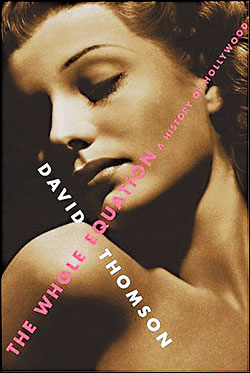David Thomson’s chronicle of the movies is not as titillatingly indiscreet as Kenneth Anger’s Hollywood Babylon or Peter Biskind’s killer tell-alls about the ’70s and indie cinema, but you should hear what he has to say about Katharine Hepburn’s presumptively bisexual brio, Bob Hope’s “ego as bold as his nose,” Jean Harlow’s unwillingness to wear panties and fatal inability to urinate, and the alleged reason accused ex–porn star Joan Crawford’s lips shone so in close-ups.
In The Whole Equation: A History of Hollywood (Knopf, $27.95), Thomson casts a piercing light on the dynamics of colliding studios, moguls, and stars. He deftly sketches the evolution of the industry’s deepest art, the deal, from Chaplin’s first Keystone contract at $150 a week to Brando’s last one: half a million a minute for his bit in Christopher Columbus: The Discovery.
Thomson can be counted as one of Pauline Kael’s two or three posthumous rivals among prose stylists writing about film. But he’s a sketch artist, not an essayist. The glory and frustration of this book is the fact that absolutely nothing compares to it except Thomson’s own long-running hit reference book, The New Biographical Dictionary of Film, just reissued with a fistful of new entries (Knopf, $22.95). The 22 pieces in Equation are like the coruscatingly clever, gleefully perverse capsule bios in his Dictionary, ballooned up and floating around like Harry Potter’s inflatable auntie, only more fun.
They are discursive pieces of subtle scholarship, insinuating charm, and no shame, whose leaps of logic are more like modernist poetry than formal argument. Yes, he gets you from The Rules of the Game to Love, Actually, but it’s one idiosyncratically syncopated story. Only faint strands of repeating themes link his free associations—the disenchantments of F. Scott Fitzgerald and Chinatown, the passions of the Mayers, Thalbergs, Chaplins and Selznicks—and if you don’t already know the broad outlines of Hollywood history, you still won’t know them after reading this book.
Thomson’s point isthat you can’t know. His title comes from Fitzgerald’s The Last Tycoon, where we’re told, “Not half a dozen men have ever been able to keep the whole equation of pictures in their heads.” Since Thomson’s alternately dim and flashy pages don’t bring us any closer to such understanding, he takes license to venture far from the studio back lot. He touches on L.A.’s natural and civic history, film technology, Hollywood politics, national politics, and the different psychology of audiences watching together in the dark or alone at home. “This is how we watch movies,” he writes, “following the old surrealist notion that there are always deep, magical affinities between and among all things.”
Some affinities are more magical than others. His esoteric meditation on Edward Hopper’s painting of a girl in a cinema is murkily purple. But his riff on the advent of talkies—often thought a disaster by stodgy supporters of pure cinema —crankily disses silents. He argues that sound rescued character from stereotype, acting from overobvious mime, plot from imbecile simplicity, and music from “coded moods—love music, danger music, fight music, chase music.” Sound added mystery, innuendo; and silent film had been barren of pregnant silences.
The coming of color was “ruinous and unforgivable,” and yet he can pine for ’30s-to-’50s Technicolor, with its “damson and crème brûlée mix as lipstick meets cheek, and its passion—because it is, often, better than life. Art is meant to be.”
Studios idiotically killed Technicolor forever, replacing it with processes that fade. So, alas, has young folks’ passion for film in a video- game (and video-game-movie) age, Thomson laments. And so has his. Watching the Godfather trilogy, he muses, “Can anyone credit that 30 years from now there will be an audience for the three parts of The Matrix, anywhere? Even if Keanu Reeves is our president?” Movies may no longer matter, but Thomson does, even when he digresses.








